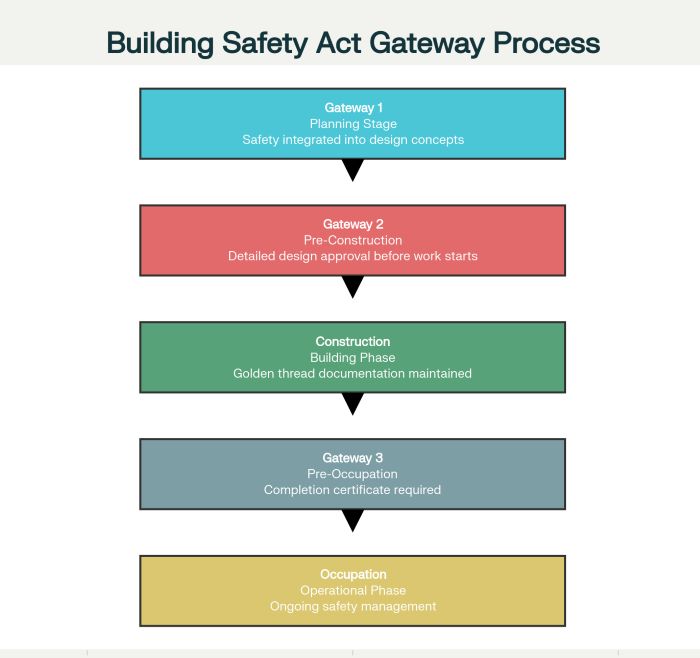How the Building Safety Act is Redefining Construction Regulations
The Building Safety Act represents the most comprehensive overhaul of building regulations in the United Kingdom in decades, fundamentally transforming how construction projects are conceived, executed, and maintained. Enacted in April 2022 following the devastating Grenfell Tower tragedy that claimed seventy-two lives, this legislation establishes rigorous frameworks that prioritize occupant safety throughout the entire building lifecycle. The Act introduces sweeping changes affecting design professionals, contractors, building owners, and residents, creating accountability structures and compliance requirements that reshape Building Safety Act construction regulations across England.
Regulatory Architecture and Governance Framework
The Building Safety Act establishes three distinct regulatory bodies that collectively oversee construction standards and enforcement. The Building Safety Regulator, operating within the Health and Safety Executive, assumes primary responsibility for overseeing safety and performance standards across all buildings while exercising special oversight for higher-risk structures. This organization possesses substantial enforcement powers, including authority to halt construction activities, impose unlimited fines, and pursue criminal prosecutions against parties failing to meet statutory obligations.
The National Regulator of Construction Products addresses systemic issues in product safety and performance that contributed to past building failures. This body oversees comprehensive construction product regulatory frameworks, leading market surveillance activities and coordinating enforcement actions across the United Kingdom. The regulator maintains authority to remove unsafe products from markets, require manufacturers to remediate defective materials, and establish enhanced testing protocols ensuring products perform as specified throughout their operational lifespans.
The New Homes Ombudsman Scheme provides recourse mechanisms for residents experiencing issues with newly constructed properties. Developers must participate in this scheme, which establishes complaint resolution procedures and enforcement frameworks. The ombudsman can investigate construction defects, order remedial work, and impose sanctions on developers failing to meet quality standards or address legitimate resident concerns. This structure creates accountability that extends beyond initial construction completion.
Gateway System and Project Progression Controls
The Act implements a three-gateway approval system for higher-risk buildings—structures containing at least two residential units standing eighteen meters or higher, or comprising seven or more stories. These gateways function as mandatory checkpoints that projects must satisfy before advancing to subsequent phases, fundamentally altering construction project management and execution.

Gateway One occurs during the planning approval stage, requiring applicants to demonstrate that safety considerations have been comprehensively integrated into initial design concepts. Planning authorities must verify that proposed buildings incorporate appropriate safety measures, fire protection systems, and evacuation provisions before granting permission to proceed. This early-stage intervention ensures safety becomes foundational to project conception rather than an afterthought during detailed design.
Gateway Two establishes pre-construction approval requirements, mandating Building Safety Regulator authorization before work commences on site. Applicants must submit detailed design documentation demonstrating compliance with building regulations, comprehensive fire safety strategies, and construction control plans outlining how safety will be managed during building activities. The regulator scrutinizes these submissions thoroughly, often requesting additional information or design modifications before issuing approval. This gateway creates hard stops that prevent construction from beginning until safety requirements are definitively satisfied.
Gateway Three represents the final checkpoint before occupation, requiring completion certificates from the Building Safety Regulator confirming that constructed buildings meet approved specifications and satisfy all regulatory requirements. Applicants must provide comprehensive documentation demonstrating that construction followed approved plans, including detailed records of materials used, installation procedures followed, and testing results validating system performance. Buildings cannot be occupied until this certificate is issued, creating powerful incentives for maintaining rigorous quality control throughout construction processes.
Golden Thread Information Requirements
The golden thread concept constitutes one of the Act’s most significant innovations, establishing requirements for comprehensive digital records that document building design, construction, and operational history. This information must be accurate, accessible, and continuously updated throughout the building’s existence, creating transparent accountability chains and enabling informed decision-making regarding safety management.
During design and construction phases, principal designers and principal contractors bear responsibility for establishing and maintaining golden thread documentation. These records must capture detailed information about structural elements, fire protection systems, materials specifications, installation procedures, and design changes implemented during construction. The information must be stored digitally in structured formats enabling efficient retrieval and analysis.
Upon completion, responsibility for the golden thread transfers to the accountable person managing occupied buildings. This individual or organization must maintain and update documentation to reflect modifications, maintenance activities, inspection results, and any incidents affecting building safety. Residents must have access to relevant portions of this information, empowering them to understand their buildings and hold managers accountable for maintaining safety standards.
The golden thread serves multiple critical functions beyond regulatory compliance. It provides emergency responders with immediate access to building layouts, system configurations, and hazardous material locations, enabling more effective incident response. It supports maintenance planning by documenting equipment specifications, maintenance schedules, and historical performance patterns. It facilitates risk assessments by providing comprehensive information about building characteristics and operational history. The requirement represents recognition that effective safety management depends fundamentally on accurate, accessible information.
Competence and Accountability Standards
The Building Safety Act construction regulations impose stringent competence requirements on construction professionals involved with higher-risk buildings. Principal designers and principal contractors must demonstrate possession of necessary skills, knowledge, and experience to manage building safety risks effectively. Clients bear responsibility for verifying competence before appointing these parties, creating accountability that flows upward through organizational hierarchies.
Competence extends beyond technical capabilities to encompass understanding of regulatory requirements, appreciation of safety risks, and commitment to maintaining standards throughout project execution. Professional bodies have developed competence frameworks defining requisite knowledge and experience levels for various roles. Construction professionals must maintain continuing professional development demonstrating ongoing competence maintenance.
The Act establishes extended liability periods recognizing that building defects may not become apparent for years following construction completion. The previous six-year limitation for claims under the Defective Premises Act has been extended to thirty years for claims arising before June 2022 and fifteen years for subsequent claims. This extension creates long-term accountability incentives, encouraging construction professionals to prioritize quality and safety knowing they may face consequences decades after project completion.
Building Liability Orders enable parties to pursue parent companies for liabilities associated with subsidiary entities, piercing corporate veils that previously allowed developers to avoid accountability through special purpose vehicle structures. This provision addresses systematic issues where developers established project-specific companies with limited assets, then dissolved these entities after construction completion, leaving residents without recourse when defects emerged.
Operational Phase Requirements and Ongoing Compliance
For occupied higher-risk buildings, the Act establishes comprehensive safety management requirements. Principal accountable persons must register buildings with the Building Safety Regulator before occupation, providing detailed information about building characteristics, safety features, and management arrangements. These parties must conduct regular safety assessments, maintain safety case reports documenting risk management approaches, and engage meaningfully with residents regarding safety matters.
Safety case reports must demonstrate that building safety risks are being managed effectively through appropriate systems, procedures, and organizational arrangements. These documents require regular review and updating to reflect changes in building use, deterioration of building elements, or emergence of new safety information. The regulator can request these reports at any time and may require modifications if documented approaches prove inadequate.
Mandatory occurrence reporting requires accountable persons to notify the regulator of significant safety events, including fires, structural failures, and situations where safety systems failed to perform as intended. This requirement creates early warning systems enabling regulators to identify emerging safety issues and intervene before problems escalate. Failure to report qualifying occurrences can result in substantial penalties.
Industry Adaptation and Future Implementation
The Building Safety Act fundamentally redefines construction regulations, establishing frameworks that prioritize occupant safety throughout building lifecycles. While compliance requirements create additional costs and administrative burdens, the legislation addresses systemic failures that contributed to tragic losses of life. As construction industry participants adapt to these new standards, the frameworks established by the Act will progressively become embedded in normal business practices, ultimately creating safer buildings and more accountable construction processes.
The implementation continues evolving through secondary legislation that operationalizes the Act’s provisions. Construction professionals must maintain awareness of developing regulations and adapt their practices accordingly. Organizations demonstrating proactive compliance with Building Safety Act principles position themselves advantageously as the construction industry adapts to this new regulatory environment.
































